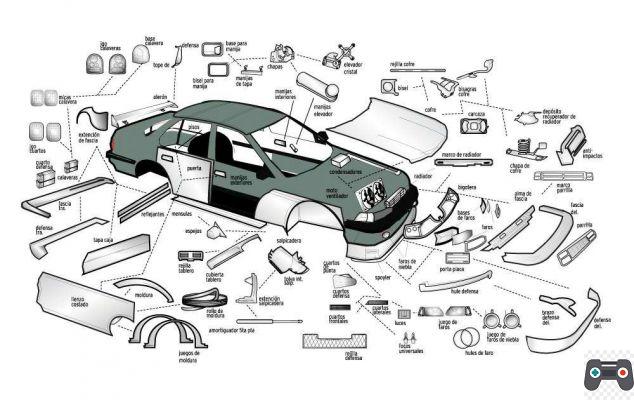
Welcome to Pistonudos.com, where we are passionate about the automotive world and we are here to provide you with all the information you need about car body parts and their components. In this article, we will provide you with an overview of the different body parts, from the monocoque body components to the exterior elements of a self-supporting body. We will also explain the names of the body parts of a car and the types and parts of the body and chassis of a car. Read on to find out everything!
1. Monocoque body components
The monocoque body is an integral structure that provides strength and rigidity to the vehicle. It is made up of several essential parts, such as:
- Side panels: are the exterior parts of the body that cover the sides of the vehicle.
- Roof panels: These are the upper body components that cover the passenger compartment of the vehicle.
- Floor Panels: These are the lower body parts that provide support and rigidity to the vehicle.
- Crossmembers: are structural elements that reinforce the rigidity of the body and help distribute energy in the event of an impact.
2. Exterior elements of a self-supporting bodywork
The self-supporting body is another type of structure common in modern automobiles. Its main exterior components include:
- Bumpers: are the front and rear parts of the bodywork that protect the vehicle in the event of a collision.
- Fenders: are the parts that cover the wheels and protect the bodywork from splashes and damage.
- Rearview mirrors: are the devices located on the sides of the vehicle that allow the driver to see the objects behind him.
- Moons: they are the crystals that form the windows of the vehicle.
3. Names of the parts of the body of a car
Knowing the names of the different parts of a car's body is important to be able to communicate effectively about it. Some of the more common parts include:
- Hood: it is the front cover of the engine.
- Trunk: It is the rear part of the vehicle where the cargo space is located.
- Doors: are the side openings that allow access to the vehicle's passenger compartment.
- Windshield: It is the front glass that protects the driver and passengers from the wind and external objects.
4. Types and parts of the body and chassis of a car
There are different types of bodywork and chassis on cars, each with its own characteristics and advantages. Some of the more common types include:
- Sedan Body: It is a four-door body type with a separate cargo compartment.
- Hatchback Body: It is a type of body with two or four doors with a tailgate that allows access to the cargo space.
- SUV bodywork: It is a taller and more robust type of bodywork, designed for off-road driving.
As for the chassis, it is the structure that supports the weight of the vehicle and its components. Some of the main parts of the chassis include:
- Frame: It is the main structure of the chassis that connects all the parts of the vehicle.
- Subframe: It is a secondary structure used to support specific components, such as the engine or suspension.
- Crossmembers: are structural elements that reinforce the rigidity of the chassis and help distribute energy in the event of an impact.
Frequently Asked Questions (FAQs)
1. What is the difference between a monocoque body and a self-supporting body?
The main difference between a monocoque body and a self-supporting body lies in its structure. The monocoque body is an integral structure that provides strength and rigidity to the vehicle, while the self-supporting body uses exterior components to achieve the same function. Both types have their own advantages and disadvantages, and your choice depends on the design and needs of the vehicle.
2. What is the importance of knowing the parts of a car body?
Knowing the parts of a car's body is important for several reasons. First, it allows you to communicate effectively on the subject, whether you're talking to a mechanic or looking up information online. Also, understanding the different parts of the body helps you better understand how your vehicle works and how to keep it in good shape. It can also be useful in the event of an accident or breakdown, as you can more accurately identify and describe the affected parts.
Conclusion
In summary, the parts of the body of a car are essential for its operation and safety. From the monocoque body components to the exterior elements of a self-supporting body, each part fulfills a specific function and contributes to the integrity of the vehicle. Knowing the names of car body parts and understanding the different types and parts of a car body and chassis is essential for any car enthusiast. We hope this article has been informative and has helped you expand your knowledge on this topic. If you have any questions or comments, feel free to leave us a message below!
Until next time at Pistonudos.com!


























